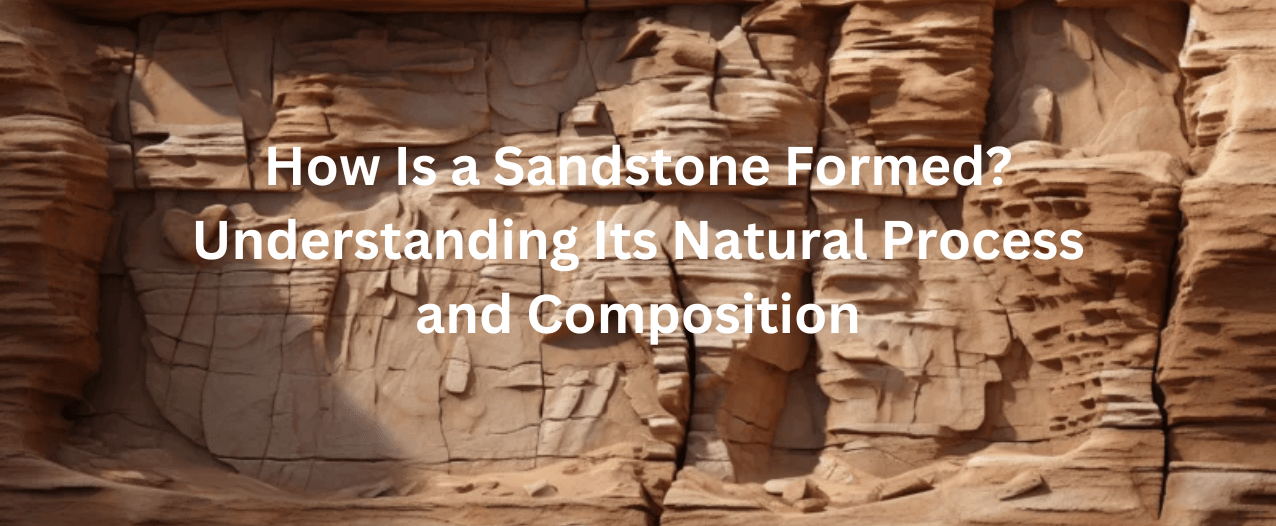The tale of sandstone is one that nature has created over millions of years. Picture a river steadily chiseling away at hard terrain, leaving behind sediments, or a wide desert where breezes transport minute grains of sand.
These microscopic particles combine throughout time to form sandstone, a very intriguing material. The problem is that it’s more than simply a rock; it’s a fragment of Earth’s past. In what way does a sandstone form? Let’s explore how is a sandstone formed through composition and natural processes.
What is Sandstone?
Before knowing how is sandstone formed, let’s first understand what it is. One of those rocks you’ve most likely seen a hundred times without really thinking about is sandstone. It is a sedimentary rock composed primarily of feldspar and quartz particles the size of sand.
The wonderful thing about it, though, is that each sandstone has a unique history. Its origin—a desert, a riverbed, or maybe an old seabed—is revealed by its color, texture, and even the small grains.
Sandstone is unique because of its adaptability. It has been utilized for ages to construct houses, create sculptures, and even serve as oil and water reservoirs. We can better appreciate its value if we know what it is composed of and how it forms.
Geological Process: How is Sandstone Formed?
The three essential processes of cementation, compaction, and sedimentation are like a natural recipe for how is sandstone formed. Let’s explore it.
Sedimentation
Sand particles are first transported to a new location by wind, water, or ice. Consider it a voyage. In rivers, ocean basins, or deserts, these particles accumulate in layers. These layers become thicker over time, laying the groundwork for future developments.
Compaction
Things start to become serious at this point. The weight begins to bear down on the sand below as layers continue to accumulate. As a result, there are fewer gaps between the grains as they are compressed closer together. Things are pushed down to make more room, much like when packing a bag.
Cementation
The finishing touch is now required. Minerals that function as glue seep into the microscopic gaps between the grains, such as silica, calcite, or iron oxide. This solidifies the loose sand into rock by binding everything together. You also get varying colors and textures based on the type of “glue” that is utilized.
Key Components of Sandstone
Now after discussing how is sandstone formed, let’s discuss the contents of sandstone. It is distinct due to a variety of factors, not only the sand.
- Quartz: The primary player is this. It is so prevalent in sandstone because it is hard and resistant.
- Feldspar: It’s not as durable as quartz, but it does add some variation in color and composition.
- Rock Fragments: Along the way, little fragments of other rocks are mixed in.
- Cementing Materials: minerals that keep everything together, such as iron oxide, calcite, or silica.
Depending on these ingredients, you get different types of sandstone. For example:
- Quartz Sandstone: Mostly quartz grains.
- Arkose: Has a lot of feldspar.
- Graywacke: A mix of rock fragments and clay.
Factors Influencing Sandstone Formation
Sandstone is not all the same. The environments it is exposed to determine a lot. What matters is this:
Environment of Deposition
The properties of the resultant sandstone are greatly influenced by the environment in which sand settles.
Layers rich in organic elements, such as shells or plant pieces, can be found in coastal or oceanic deposits, giving the sandstone a distinctive texture.
Climate
The rock formation is influenced by climate, in addition to ecosystems. Sandstone frequently becomes reddish or orange in warm, dry climates because of iron oxides.
On the other hand, the mineral makeup and climatic factors may cause sandstone that was created in wetter climates to look lighter in color.
Geological Time Frame
Sediment layers build up and compress under tremendous pressure over millions of years. While slow, progressive sedimentation guarantees a strong rock structure, rapid sedimentation may produce loosely packed grains.
This longer period of time also permits cementing minerals to seep in, strengthening and prolonging the sandstone’s resilience.
Biological Activity
Sandstone is not an exception to the rule that nature leaves its mark everywhere. In certain instances, its creation is influenced by biological activity.
Over time, microscopic creatures, plant waste, and pieces of organic material shells can affect the sandstone’s structure, color, and even porosity, forming a natural mosaic that reveals the origin of the stone.
What is the Role of Sandstone in Earth’s Ecosystem
Sandstone isn’t just another rock lying around; it plays an important role in the environment. Here’s how:
Habitat Formation
Have you ever seen sandstone cliffs or caverns? Not only are they beautiful, but they are also home to animals, plants, and occasionally even people. Small creatures find refuge there, plants grow in the cracks, and birds build their nests.
Water Reservoirs
Sandstone block’s ability to be permeable is one of its greatest features. This makes it a fantastic natural reservoir since it can store water. Sandstone is responsible for the existence of several aquifers worldwide.
Soil Formation
Sandstone weathers and turns into soil, which enriches the earth with nutrients necessary for plant growth.
In certain situations, sandstone strata serve as a natural barrier and stabilize landscapes by halting excessive erosion.
Geological Stability
Conclusion
Sandstone tells stories and is more than simply a rock. Its history, from its earliest stages as loose sand grains to its development into a solid, multipurpose substance, is nothing short of amazing.
If you are looking for a reliable sandstone supplier then Maroota Sandstone can be your best partner. We are the leading sandstone merchants in Australia that provide quality with durability.
FAQ’s
1. How is a sandstone formed?
Ans: When minerals like silica or calcite deposit, compress, and cement sand-sized particles together, sandstone is created. Millions of years may pass throughout this procedure.
2. What minerals are commonly found in sandstone?
Ans: Typically, sandstone is composed of feldspar and quartz, with trace quantities of rock fragments and cementing agents like iron oxide or silica.
3. How long does it take for sandstone to form?
Ans: It’s not a quick process! Sandstone formation can take millions of years, depending on environmental conditions and the rate of sedimentation.
4. Where is sandstone commonly found?
Ans: Riverbeds, ocean bottoms, and deserts are common places to find sandstone. The Grand Canyon in the United States and Uluru (Ayers Rock) in Australia are well-known examples.
5. What are the uses of sandstone?
Ans: Sandstone is frequently utilized in sculpting, building, and as a fossil fuel and water reservoir. It is a choice for many applications due to its strength and beauty.




